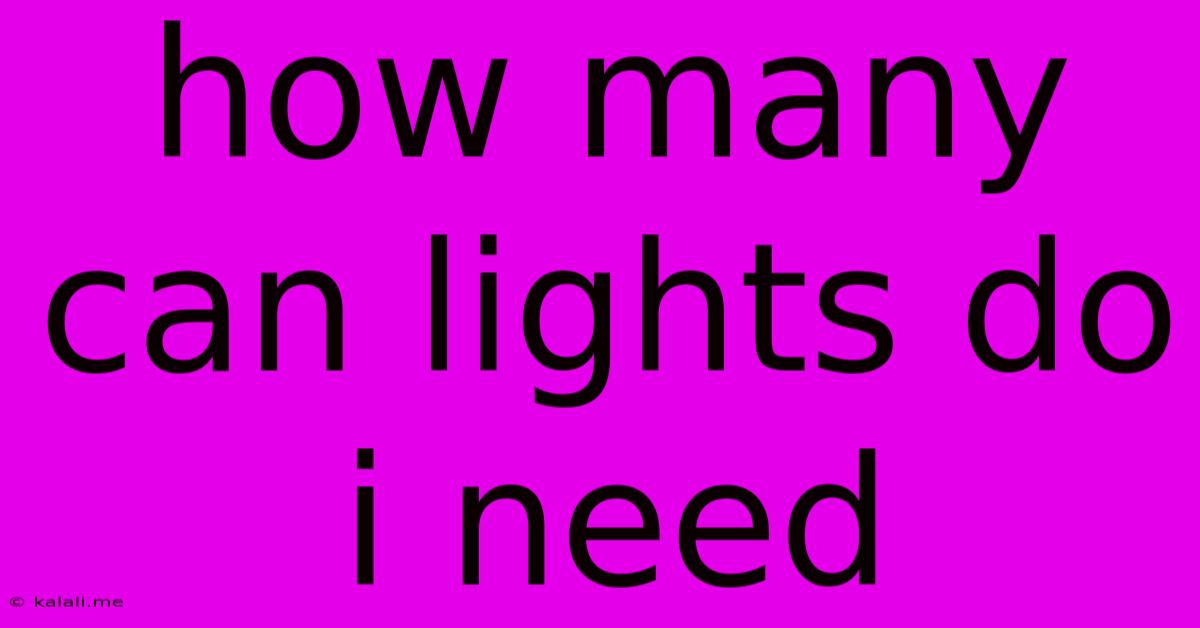How Many Can Lights Do I Need
Kalali
May 31, 2025 · 3 min read

Table of Contents
How Many Can Lights Do I Need? A Comprehensive Guide to Lighting Your Home
Determining the right number of can lights for your room can be tricky. Too few, and your space will feel dimly lit and cramped. Too many, and you'll have harsh, glaring illumination and a potentially high electricity bill. This guide will walk you through calculating the perfect amount of recessed lighting for any room in your house. We'll cover factors like room size, ceiling height, desired ambiance, and more.
Understanding the Basics: Lumens, Foot-Candles, and More
Before diving into calculations, let's clarify some key lighting terms:
- Lumens (lm): This measures the total amount of light emitted by a light source. A higher lumen rating means a brighter light.
- Foot-candles (fc): This measures the amount of light falling on a surface. It's often used to determine the appropriate lighting level for different tasks and environments.
- Color temperature (Kelvin): This indicates the "warmth" or "coolness" of the light. Lower Kelvin values (2700K-3000K) produce warmer, more yellowish light, while higher values (5000K-6500K) produce cooler, bluer light.
Calculating the Number of Can Lights: A Step-by-Step Approach
There isn't a single magic formula, but here's a practical approach combining several methods:
1. Determine the Required Foot-Candles:
This depends on the room's function:
- Living Room/Bedroom: 10-20 fc
- Kitchen: 30-50 fc (consider task lighting for counters and sinks)
- Bathroom: 70-80 fc (higher for vanity areas)
- Hallway: 10-15 fc
2. Measure Your Room:
Calculate the square footage of the room (length x width).
3. Estimate Lumens Per Fixture:
Typical can lights range from 500 to 1000 lumens. Consider energy-efficient LED options.
4. Calculate the Total Lumens Needed:
Multiply the desired foot-candles by the square footage of the room. This gives you the total lumens needed for adequate illumination.
5. Determine the Number of Can Lights:
Divide the total lumens needed by the lumens per fixture to get the approximate number of can lights required.
Example:
Let's say you have a 150 sq ft living room aiming for 15 fc. You'll need 150 sq ft * 15 fc = 2250 lumens. If you use 650-lumen can lights, you'd need approximately 2250 lumens / 650 lumens/light ≈ 3.5 lights. Round up to 4 can lights for even coverage.
Beyond the Calculations: Crucial Considerations
- Ceiling Height: Higher ceilings require more lights to achieve the same illumination level.
- Room Shape: Oddly shaped rooms might need strategic placement to avoid dark corners.
- Ambient Lighting: Consider existing light sources like windows, floor lamps, or chandeliers. These can reduce the number of can lights needed.
- Light Fixture Placement: Avoid placing lights directly above furniture to prevent glare. Spread them evenly across the ceiling.
- Dimmers: Dimmers provide flexibility and control over the ambiance.
- Task Lighting: Incorporate additional task lighting (under-cabinet lighting in the kitchen, for example) for specific areas requiring brighter illumination.
Conclusion:
Calculating the ideal number of can lights involves understanding your lighting needs and employing a systematic approach. Remember that the calculations provide an estimate; adjust the number of lights based on your observations and desired ambiance. Prioritizing even light distribution and considering additional lighting sources will ensure a well-lit and comfortable living space.
Latest Posts
Latest Posts
-
Ffmpeg Variable Frame Rate To Constant
Jun 01, 2025
-
How To Drill Into Meta Door
Jun 01, 2025
-
Laminate To Tile Without Transition Strip
Jun 01, 2025
-
No Sin Is Greater Than Another
Jun 01, 2025
-
Water Pressure Low After Turning Water Back On
Jun 01, 2025
Related Post
Thank you for visiting our website which covers about How Many Can Lights Do I Need . We hope the information provided has been useful to you. Feel free to contact us if you have any questions or need further assistance. See you next time and don't miss to bookmark.